International Economics Report: COVID-19 and Education in Bangladesh
VerifiedAdded on 2022/04/04
|28
|9679
|31
Report
AI Summary
This report, submitted to the Department of International Business at the University of Dhaka, examines the wide-ranging impacts of the COVID-19 pandemic on the education system of Bangladesh. The report explores the closure of educational institutions, the shift to online learning, and the challenges faced by students and educators. It delves into the origin and spread of the virus, the government's response, and the limitations of the study. The report analyzes the scope, objectives, and methodology used, including the use of secondary data from various sources. It also assesses the difficulties students face, the need for government intervention, and the practical realities of online education in rural areas. The report further includes findings from primary data, survey measures, and recommendations for mitigating the negative effects of the pandemic on education. The report concludes with an overview of the current state of education during the pandemic.
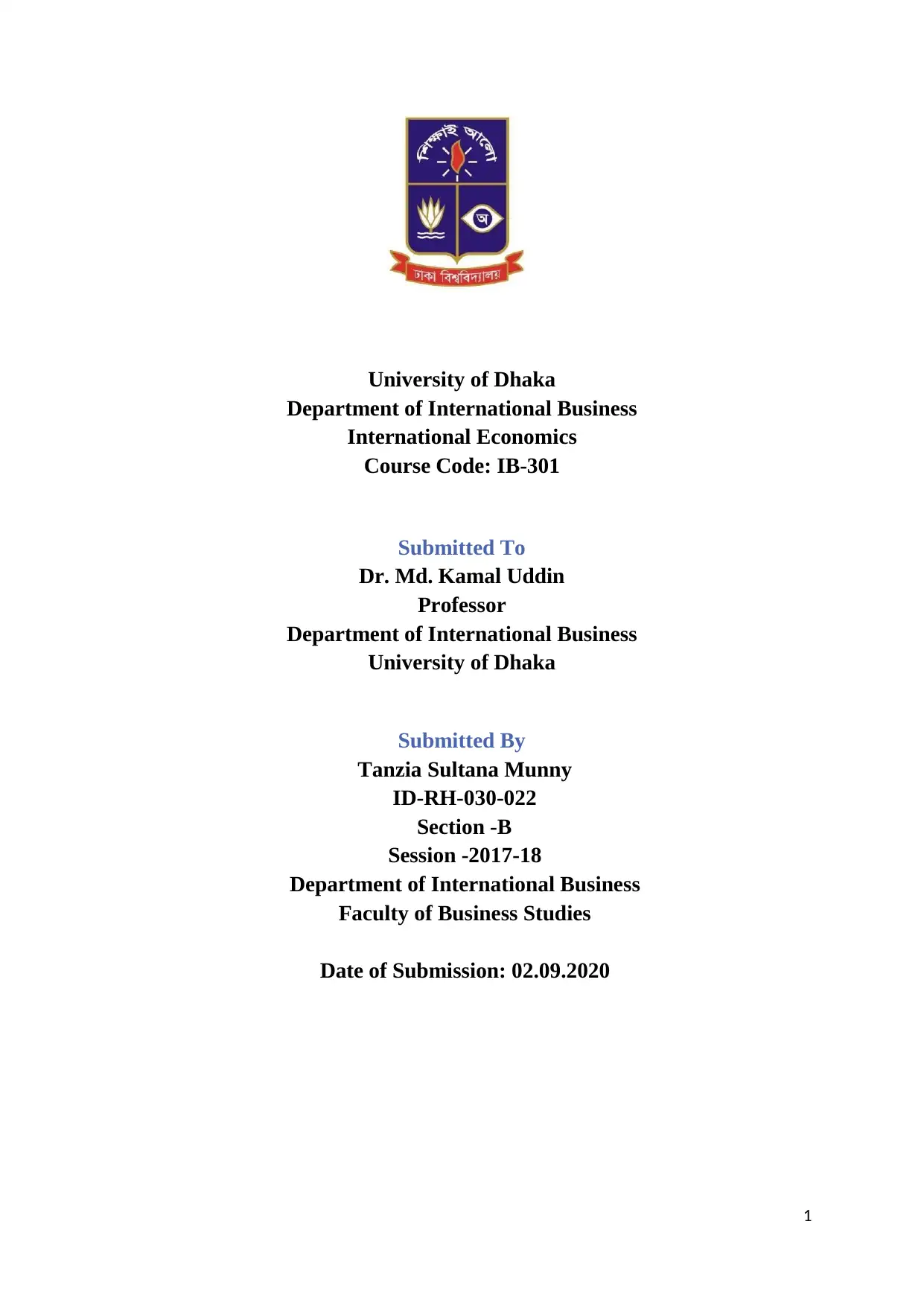
1
University of Dhaka
Department of International Business
International Economics
Course Code: IB-301
Submitted To
Dr. Md. Kamal Uddin
Professor
Department of International Business
University of Dhaka
Submitted By
Tanzia Sultana Munny
ID-RH-030-022
Section -B
Session -2017-18
Department of International Business
Faculty of Business Studies
Date of Submission: 02.09.2020
University of Dhaka
Department of International Business
International Economics
Course Code: IB-301
Submitted To
Dr. Md. Kamal Uddin
Professor
Department of International Business
University of Dhaka
Submitted By
Tanzia Sultana Munny
ID-RH-030-022
Section -B
Session -2017-18
Department of International Business
Faculty of Business Studies
Date of Submission: 02.09.2020
Paraphrase This Document
Need a fresh take? Get an instant paraphrase of this document with our AI Paraphraser
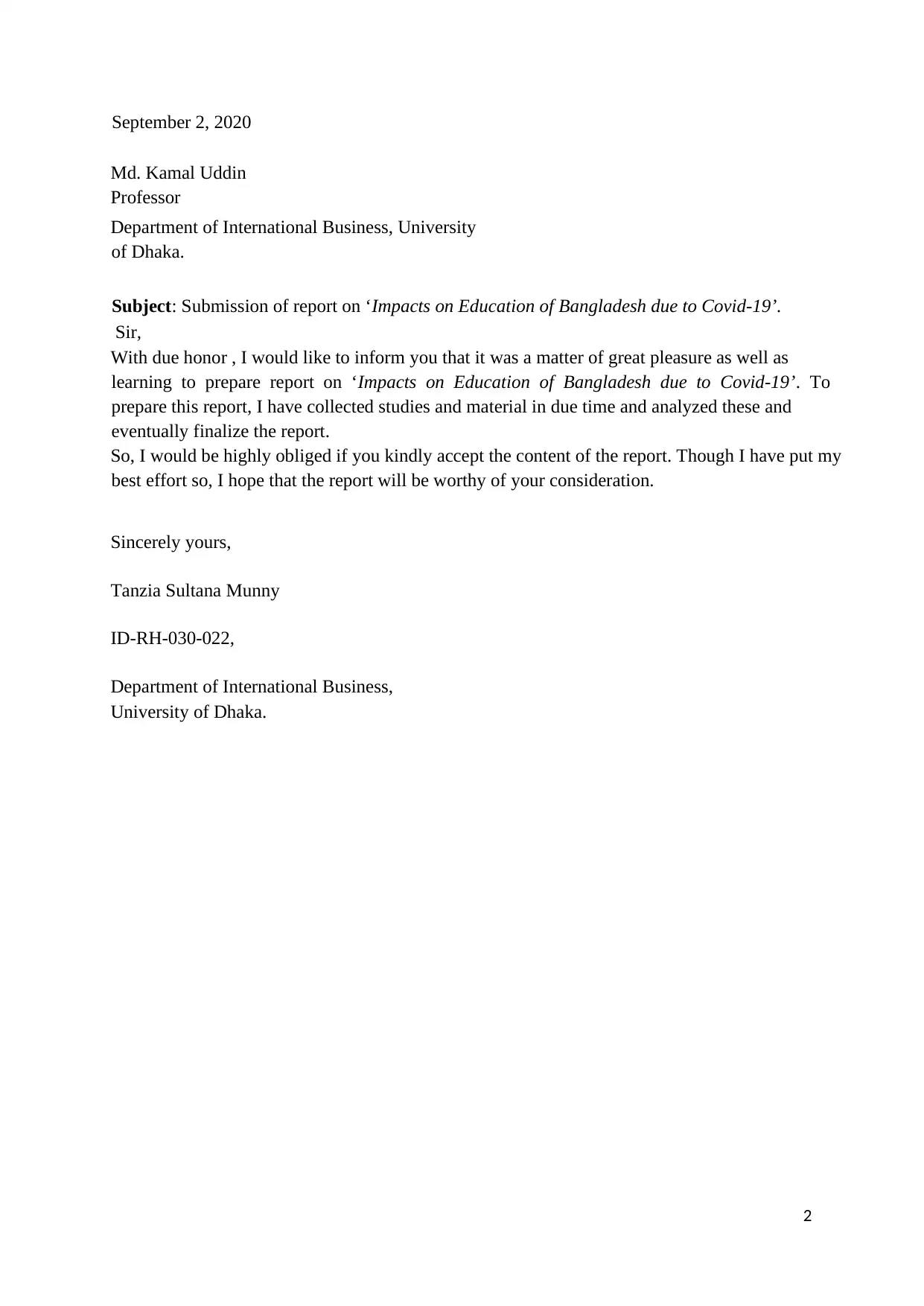
2
September 2, 2020
Md. Kamal Uddin
Professor
Department of International Business, University
of Dhaka.
Subject: Submission of report on ‘Impacts on Education of Bangladesh due to Covid-19’.
Sir,
With due honor , I would like to inform you that it was a matter of great pleasure as well as
learning to prepare report on ‘Impacts on Education of Bangladesh due to Covid-19’. To
prepare this report, I have collected studies and material in due time and analyzed these and
eventually finalize the report.
So, I would be highly obliged if you kindly accept the content of the report. Though I have put my
best effort so, I hope that the report will be worthy of your consideration.
Sincerely yours,
Tanzia Sultana Munny
ID-RH-030-022,
Department of International Business,
University of Dhaka.
September 2, 2020
Md. Kamal Uddin
Professor
Department of International Business, University
of Dhaka.
Subject: Submission of report on ‘Impacts on Education of Bangladesh due to Covid-19’.
Sir,
With due honor , I would like to inform you that it was a matter of great pleasure as well as
learning to prepare report on ‘Impacts on Education of Bangladesh due to Covid-19’. To
prepare this report, I have collected studies and material in due time and analyzed these and
eventually finalize the report.
So, I would be highly obliged if you kindly accept the content of the report. Though I have put my
best effort so, I hope that the report will be worthy of your consideration.
Sincerely yours,
Tanzia Sultana Munny
ID-RH-030-022,
Department of International Business,
University of Dhaka.
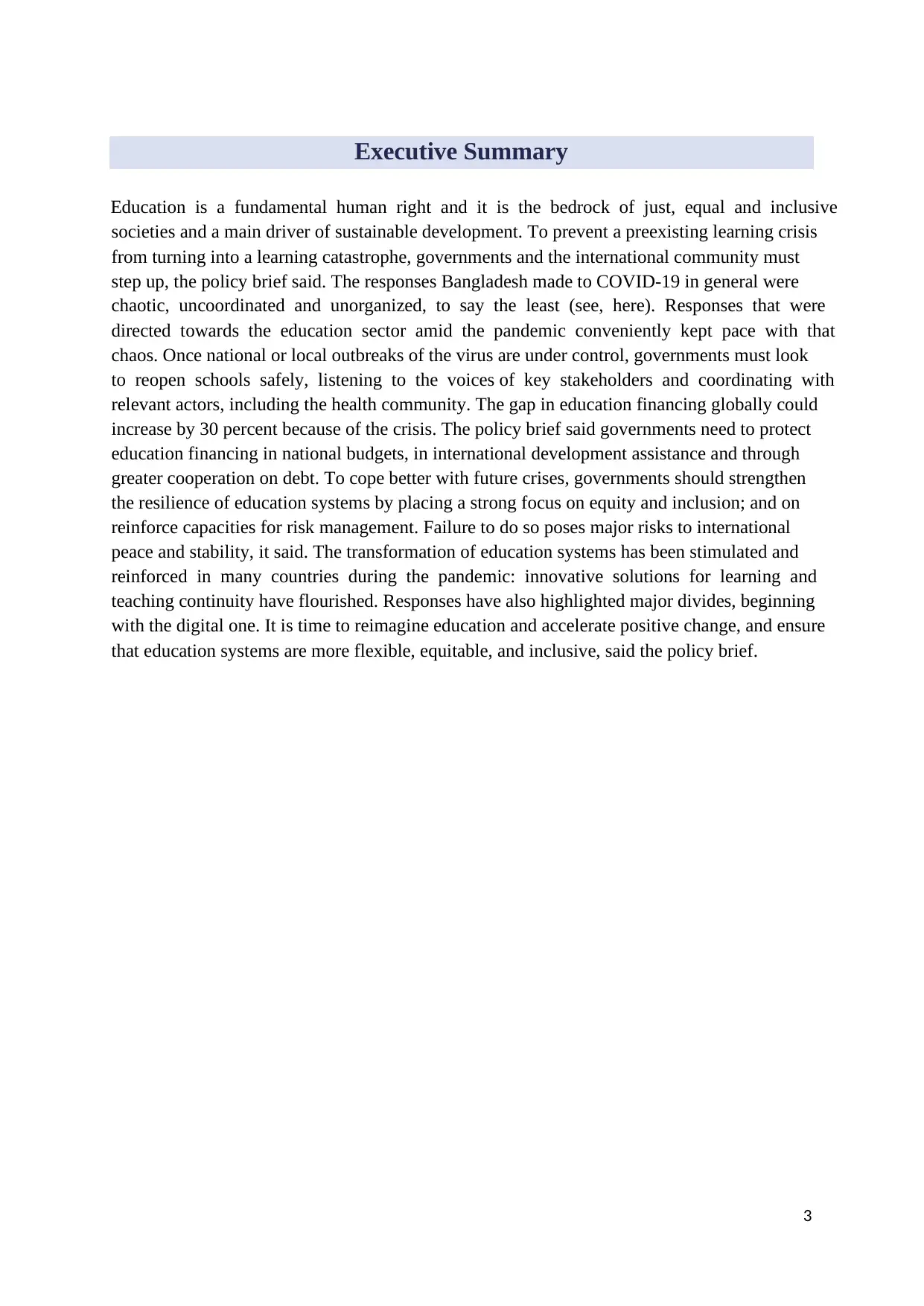
3
Executive Summary
Education is a fundamental human right and it is the bedrock of just, equal and inclusive
societies and a main driver of sustainable development. To prevent a preexisting learning crisis
from turning into a learning catastrophe, governments and the international community must
step up, the policy brief said. The responses Bangladesh made to COVID-19 in general were
chaotic, uncoordinated and unorganized, to say the least (see, here). Responses that were
directed towards the education sector amid the pandemic conveniently kept pace with that
chaos. Once national or local outbreaks of the virus are under control, governments must look
to reopen schools safely, listening to the voices of key stakeholders and coordinating with
relevant actors, including the health community. The gap in education financing globally could
increase by 30 percent because of the crisis. The policy brief said governments need to protect
education financing in national budgets, in international development assistance and through
greater cooperation on debt. To cope better with future crises, governments should strengthen
the resilience of education systems by placing a strong focus on equity and inclusion; and on
reinforce capacities for risk management. Failure to do so poses major risks to international
peace and stability, it said. The transformation of education systems has been stimulated and
reinforced in many countries during the pandemic: innovative solutions for learning and
teaching continuity have flourished. Responses have also highlighted major divides, beginning
with the digital one. It is time to reimagine education and accelerate positive change, and ensure
that education systems are more flexible, equitable, and inclusive, said the policy brief.
Executive Summary
Education is a fundamental human right and it is the bedrock of just, equal and inclusive
societies and a main driver of sustainable development. To prevent a preexisting learning crisis
from turning into a learning catastrophe, governments and the international community must
step up, the policy brief said. The responses Bangladesh made to COVID-19 in general were
chaotic, uncoordinated and unorganized, to say the least (see, here). Responses that were
directed towards the education sector amid the pandemic conveniently kept pace with that
chaos. Once national or local outbreaks of the virus are under control, governments must look
to reopen schools safely, listening to the voices of key stakeholders and coordinating with
relevant actors, including the health community. The gap in education financing globally could
increase by 30 percent because of the crisis. The policy brief said governments need to protect
education financing in national budgets, in international development assistance and through
greater cooperation on debt. To cope better with future crises, governments should strengthen
the resilience of education systems by placing a strong focus on equity and inclusion; and on
reinforce capacities for risk management. Failure to do so poses major risks to international
peace and stability, it said. The transformation of education systems has been stimulated and
reinforced in many countries during the pandemic: innovative solutions for learning and
teaching continuity have flourished. Responses have also highlighted major divides, beginning
with the digital one. It is time to reimagine education and accelerate positive change, and ensure
that education systems are more flexible, equitable, and inclusive, said the policy brief.
⊘ This is a preview!⊘
Do you want full access?
Subscribe today to unlock all pages.

Trusted by 1+ million students worldwide
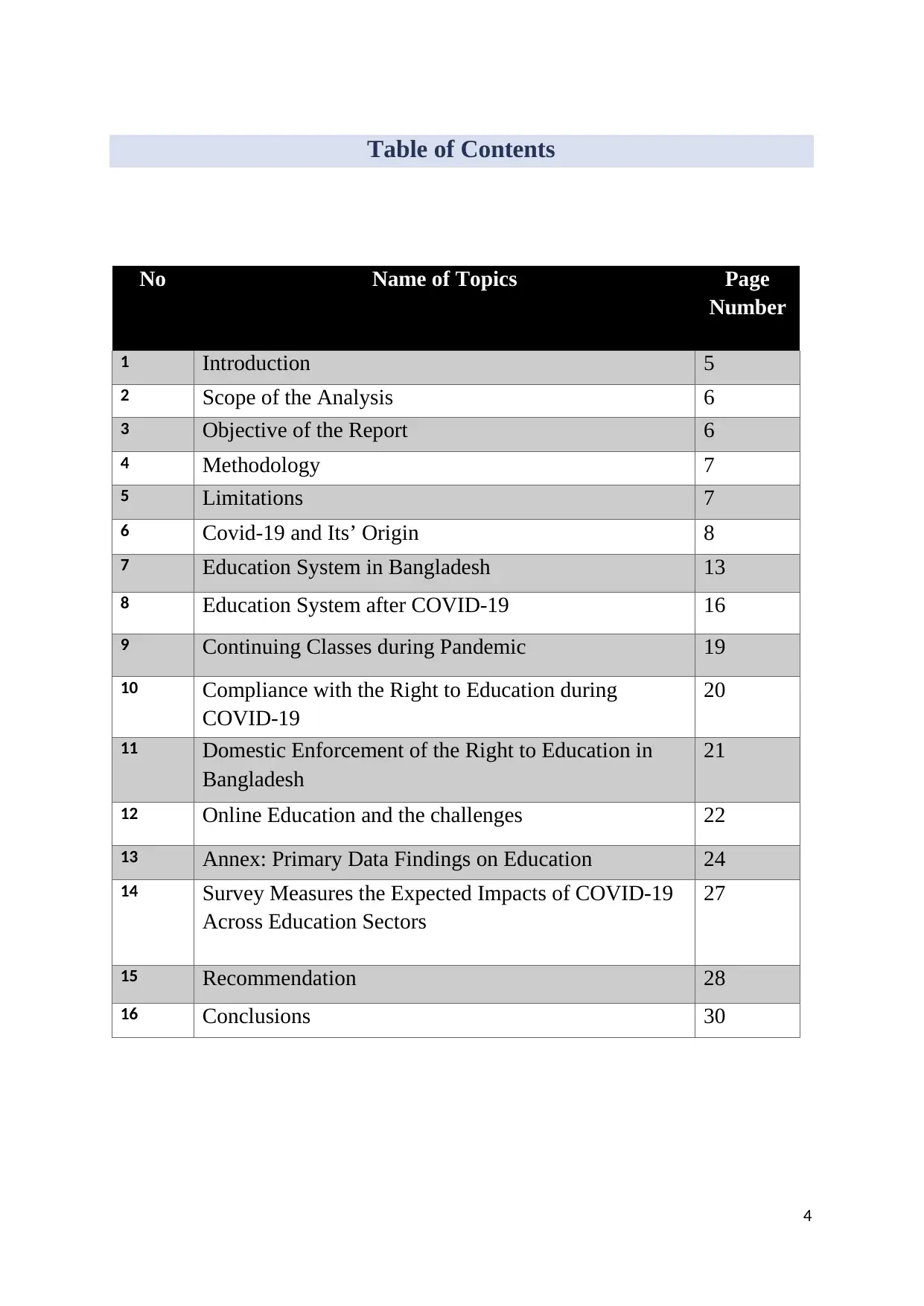
4
Table of Contents
No Name of Topics Page
Number
1 Introduction 5
2 Scope of the Analysis 6
3 Objective of the Report 6
4 Methodology 7
5 Limitations 7
6 Covid-19 and Its’ Origin 8
7 Education System in Bangladesh 13
8 Education System after COVID-19 16
9 Continuing Classes during Pandemic 19
10 Compliance with the Right to Education during
COVID-19
20
11 Domestic Enforcement of the Right to Education in
Bangladesh
21
12 Online Education and the challenges 22
13 Annex: Primary Data Findings on Education 24
14 Survey Measures the Expected Impacts of COVID-19
Across Education Sectors
27
15 Recommendation 28
16 Conclusions 30
Table of Contents
No Name of Topics Page
Number
1 Introduction 5
2 Scope of the Analysis 6
3 Objective of the Report 6
4 Methodology 7
5 Limitations 7
6 Covid-19 and Its’ Origin 8
7 Education System in Bangladesh 13
8 Education System after COVID-19 16
9 Continuing Classes during Pandemic 19
10 Compliance with the Right to Education during
COVID-19
20
11 Domestic Enforcement of the Right to Education in
Bangladesh
21
12 Online Education and the challenges 22
13 Annex: Primary Data Findings on Education 24
14 Survey Measures the Expected Impacts of COVID-19
Across Education Sectors
27
15 Recommendation 28
16 Conclusions 30
Paraphrase This Document
Need a fresh take? Get an instant paraphrase of this document with our AI Paraphraser
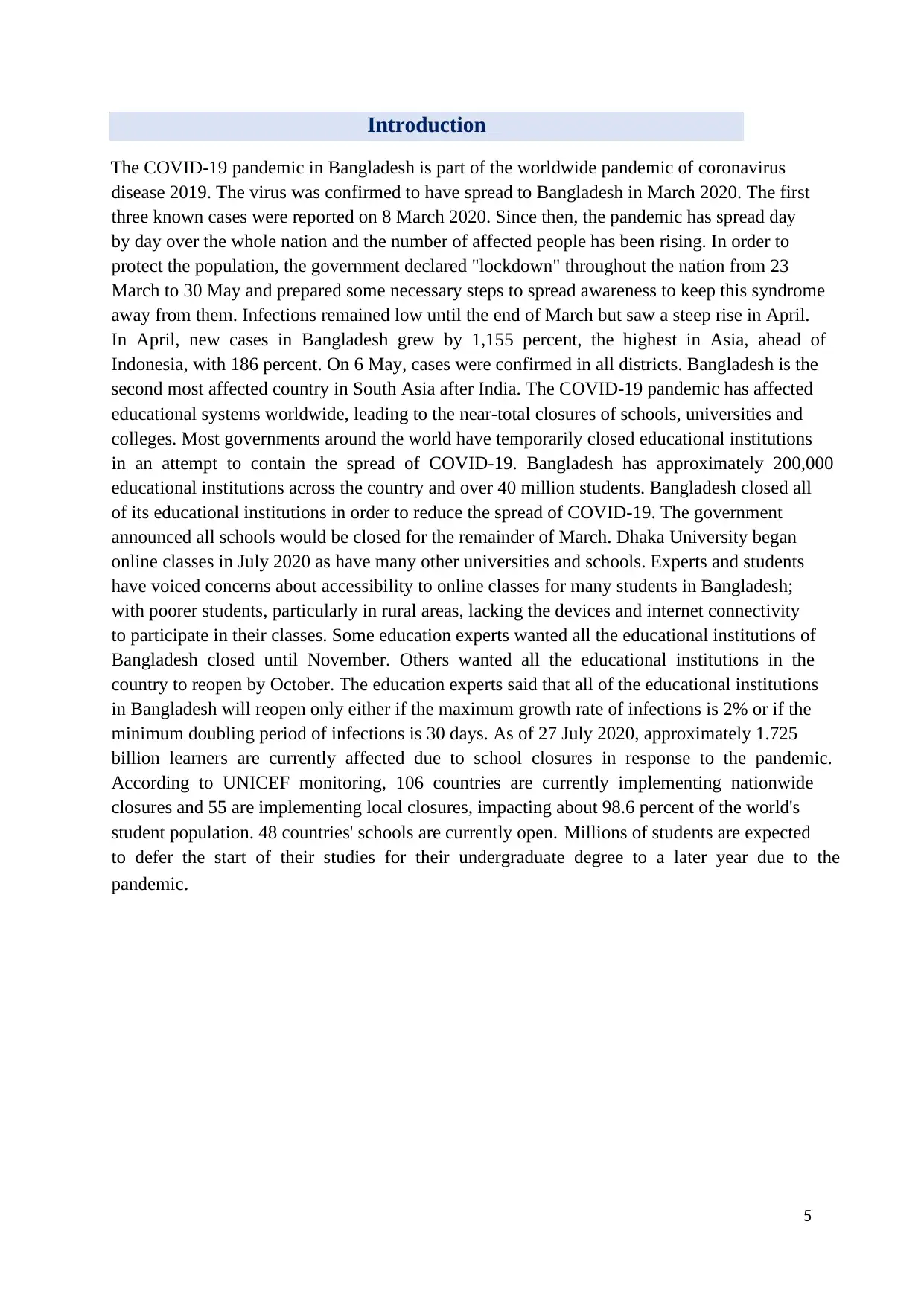
5
Introduction
The COVID-19 pandemic in Bangladesh is part of the worldwide pandemic of coronavirus
disease 2019. The virus was confirmed to have spread to Bangladesh in March 2020. The first
three known cases were reported on 8 March 2020. Since then, the pandemic has spread day
by day over the whole nation and the number of affected people has been rising. In order to
protect the population, the government declared "lockdown" throughout the nation from 23
March to 30 May and prepared some necessary steps to spread awareness to keep this syndrome
away from them. Infections remained low until the end of March but saw a steep rise in April.
In April, new cases in Bangladesh grew by 1,155 percent, the highest in Asia, ahead of
Indonesia, with 186 percent. On 6 May, cases were confirmed in all districts. Bangladesh is the
second most affected country in South Asia after India. The COVID-19 pandemic has affected
educational systems worldwide, leading to the near-total closures of schools, universities and
colleges. Most governments around the world have temporarily closed educational institutions
in an attempt to contain the spread of COVID-19. Bangladesh has approximately 200,000
educational institutions across the country and over 40 million students. Bangladesh closed all
of its educational institutions in order to reduce the spread of COVID-19. The government
announced all schools would be closed for the remainder of March. Dhaka University began
online classes in July 2020 as have many other universities and schools. Experts and students
have voiced concerns about accessibility to online classes for many students in Bangladesh;
with poorer students, particularly in rural areas, lacking the devices and internet connectivity
to participate in their classes. Some education experts wanted all the educational institutions of
Bangladesh closed until November. Others wanted all the educational institutions in the
country to reopen by October. The education experts said that all of the educational institutions
in Bangladesh will reopen only either if the maximum growth rate of infections is 2% or if the
minimum doubling period of infections is 30 days. As of 27 July 2020, approximately 1.725
billion learners are currently affected due to school closures in response to the pandemic.
According to UNICEF monitoring, 106 countries are currently implementing nationwide
closures and 55 are implementing local closures, impacting about 98.6 percent of the world's
student population. 48 countries' schools are currently open. Millions of students are expected
to defer the start of their studies for their undergraduate degree to a later year due to the
pandemic.
Introduction
The COVID-19 pandemic in Bangladesh is part of the worldwide pandemic of coronavirus
disease 2019. The virus was confirmed to have spread to Bangladesh in March 2020. The first
three known cases were reported on 8 March 2020. Since then, the pandemic has spread day
by day over the whole nation and the number of affected people has been rising. In order to
protect the population, the government declared "lockdown" throughout the nation from 23
March to 30 May and prepared some necessary steps to spread awareness to keep this syndrome
away from them. Infections remained low until the end of March but saw a steep rise in April.
In April, new cases in Bangladesh grew by 1,155 percent, the highest in Asia, ahead of
Indonesia, with 186 percent. On 6 May, cases were confirmed in all districts. Bangladesh is the
second most affected country in South Asia after India. The COVID-19 pandemic has affected
educational systems worldwide, leading to the near-total closures of schools, universities and
colleges. Most governments around the world have temporarily closed educational institutions
in an attempt to contain the spread of COVID-19. Bangladesh has approximately 200,000
educational institutions across the country and over 40 million students. Bangladesh closed all
of its educational institutions in order to reduce the spread of COVID-19. The government
announced all schools would be closed for the remainder of March. Dhaka University began
online classes in July 2020 as have many other universities and schools. Experts and students
have voiced concerns about accessibility to online classes for many students in Bangladesh;
with poorer students, particularly in rural areas, lacking the devices and internet connectivity
to participate in their classes. Some education experts wanted all the educational institutions of
Bangladesh closed until November. Others wanted all the educational institutions in the
country to reopen by October. The education experts said that all of the educational institutions
in Bangladesh will reopen only either if the maximum growth rate of infections is 2% or if the
minimum doubling period of infections is 30 days. As of 27 July 2020, approximately 1.725
billion learners are currently affected due to school closures in response to the pandemic.
According to UNICEF monitoring, 106 countries are currently implementing nationwide
closures and 55 are implementing local closures, impacting about 98.6 percent of the world's
student population. 48 countries' schools are currently open. Millions of students are expected
to defer the start of their studies for their undergraduate degree to a later year due to the
pandemic.
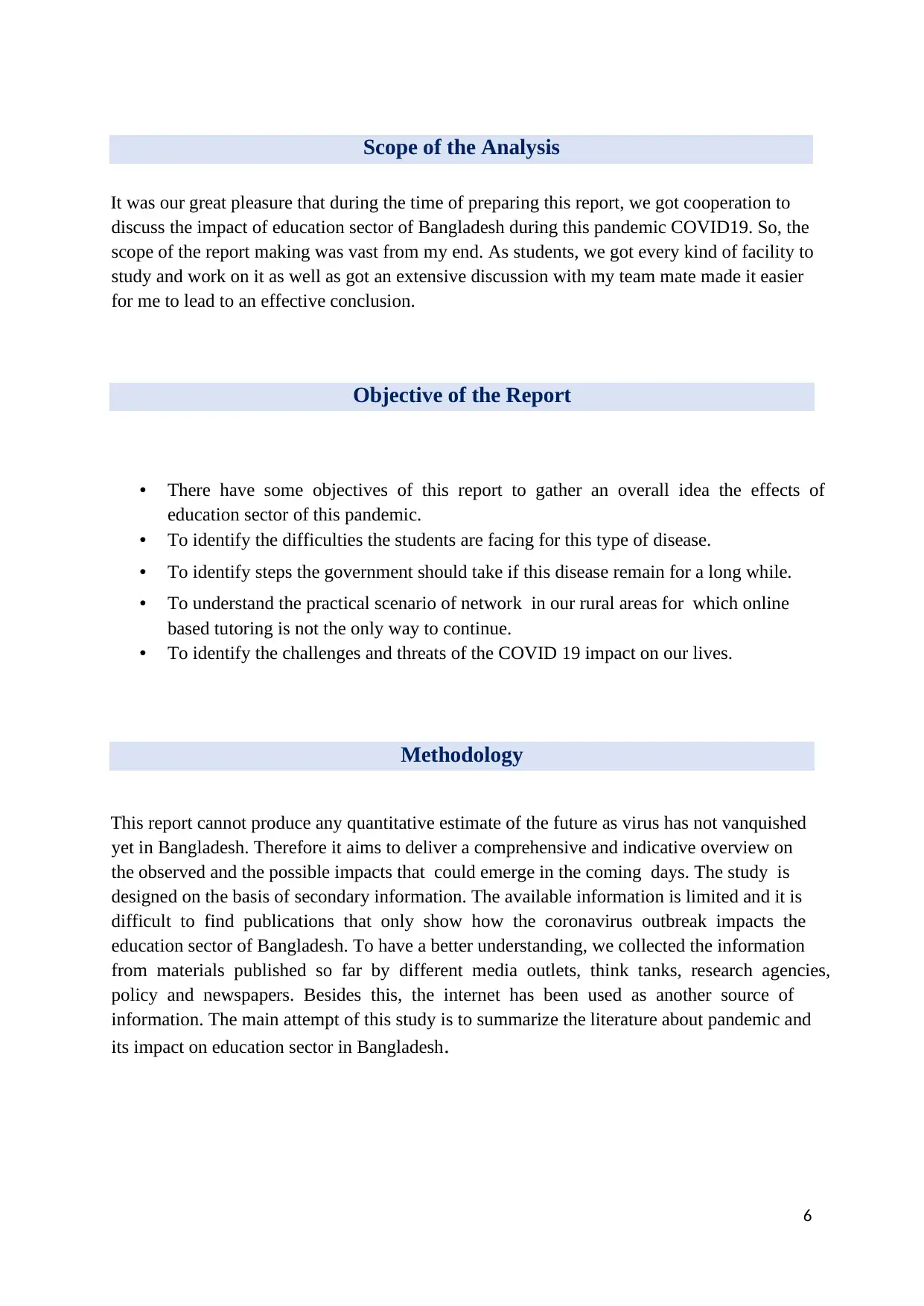
6
Scope of the Analysis
It was our great pleasure that during the time of preparing this report, we got cooperation to
discuss the impact of education sector of Bangladesh during this pandemic COVID19. So, the
scope of the report making was vast from my end. As students, we got every kind of facility to
study and work on it as well as got an extensive discussion with my team mate made it easier
for me to lead to an effective conclusion.
Objective of the Report
• There have some objectives of this report to gather an overall idea the effects of
education sector of this pandemic.
• To identify the difficulties the students are facing for this type of disease.
• To identify steps the government should take if this disease remain for a long while.
• To understand the practical scenario of network in our rural areas for which online
based tutoring is not the only way to continue.
• To identify the challenges and threats of the COVID 19 impact on our lives.
Methodology
This report cannot produce any quantitative estimate of the future as virus has not vanquished
yet in Bangladesh. Therefore it aims to deliver a comprehensive and indicative overview on
the observed and the possible impacts that could emerge in the coming days. The study is
designed on the basis of secondary information. The available information is limited and it is
difficult to find publications that only show how the coronavirus outbreak impacts the
education sector of Bangladesh. To have a better understanding, we collected the information
from materials published so far by different media outlets, think tanks, research agencies,
policy and newspapers. Besides this, the internet has been used as another source of
information. The main attempt of this study is to summarize the literature about pandemic and
its impact on education sector in Bangladesh.
Scope of the Analysis
It was our great pleasure that during the time of preparing this report, we got cooperation to
discuss the impact of education sector of Bangladesh during this pandemic COVID19. So, the
scope of the report making was vast from my end. As students, we got every kind of facility to
study and work on it as well as got an extensive discussion with my team mate made it easier
for me to lead to an effective conclusion.
Objective of the Report
• There have some objectives of this report to gather an overall idea the effects of
education sector of this pandemic.
• To identify the difficulties the students are facing for this type of disease.
• To identify steps the government should take if this disease remain for a long while.
• To understand the practical scenario of network in our rural areas for which online
based tutoring is not the only way to continue.
• To identify the challenges and threats of the COVID 19 impact on our lives.
Methodology
This report cannot produce any quantitative estimate of the future as virus has not vanquished
yet in Bangladesh. Therefore it aims to deliver a comprehensive and indicative overview on
the observed and the possible impacts that could emerge in the coming days. The study is
designed on the basis of secondary information. The available information is limited and it is
difficult to find publications that only show how the coronavirus outbreak impacts the
education sector of Bangladesh. To have a better understanding, we collected the information
from materials published so far by different media outlets, think tanks, research agencies,
policy and newspapers. Besides this, the internet has been used as another source of
information. The main attempt of this study is to summarize the literature about pandemic and
its impact on education sector in Bangladesh.
⊘ This is a preview!⊘
Do you want full access?
Subscribe today to unlock all pages.

Trusted by 1+ million students worldwide
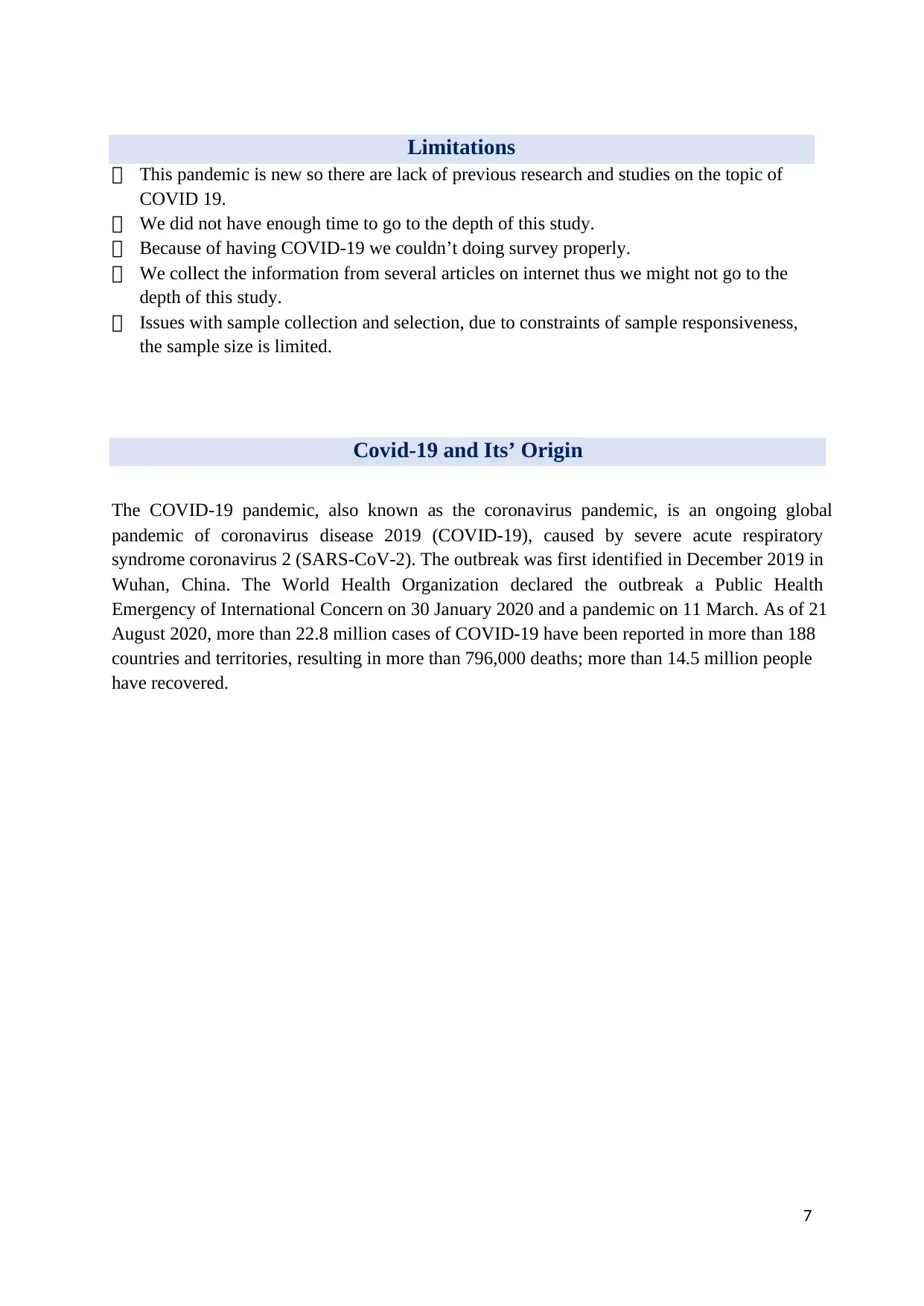
7
Limitations
This pandemic is new so there are lack of previous research and studies on the topic of
COVID 19.
We did not have enough time to go to the depth of this study.
Because of having COVID-19 we couldn’t doing survey properly.
We collect the information from several articles on internet thus we might not go to the
depth of this study.
Issues with sample collection and selection, due to constraints of sample responsiveness,
the sample size is limited.
Covid-19 and Its’ Origin
The COVID-19 pandemic, also known as the coronavirus pandemic, is an ongoing global
pandemic of coronavirus disease 2019 (COVID-19), caused by severe acute respiratory
syndrome coronavirus 2 (SARS-CoV-2). The outbreak was first identified in December 2019 in
Wuhan, China. The World Health Organization declared the outbreak a Public Health
Emergency of International Concern on 30 January 2020 and a pandemic on 11 March. As of 21
August 2020, more than 22.8 million cases of COVID-19 have been reported in more than 188
countries and territories, resulting in more than 796,000 deaths; more than 14.5 million people
have recovered.
Limitations
This pandemic is new so there are lack of previous research and studies on the topic of
COVID 19.
We did not have enough time to go to the depth of this study.
Because of having COVID-19 we couldn’t doing survey properly.
We collect the information from several articles on internet thus we might not go to the
depth of this study.
Issues with sample collection and selection, due to constraints of sample responsiveness,
the sample size is limited.
Covid-19 and Its’ Origin
The COVID-19 pandemic, also known as the coronavirus pandemic, is an ongoing global
pandemic of coronavirus disease 2019 (COVID-19), caused by severe acute respiratory
syndrome coronavirus 2 (SARS-CoV-2). The outbreak was first identified in December 2019 in
Wuhan, China. The World Health Organization declared the outbreak a Public Health
Emergency of International Concern on 30 January 2020 and a pandemic on 11 March. As of 21
August 2020, more than 22.8 million cases of COVID-19 have been reported in more than 188
countries and territories, resulting in more than 796,000 deaths; more than 14.5 million people
have recovered.
Paraphrase This Document
Need a fresh take? Get an instant paraphrase of this document with our AI Paraphraser
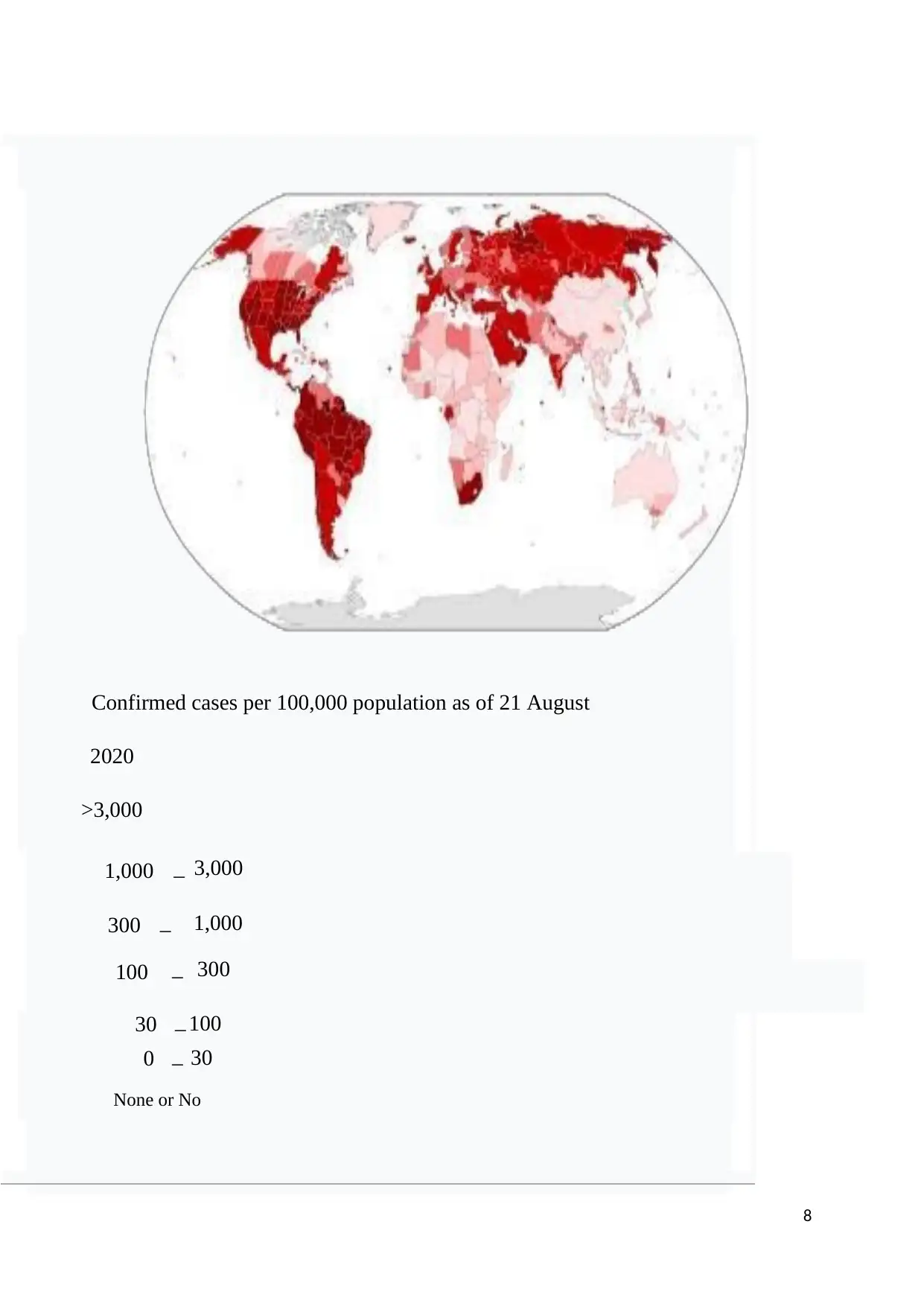
8
Confirmed cases per 100,000 population as of 21 August
2020
>3,000
1,000 – 3,000
300 – 1,000
100 – 300
30 – 100
0 – 30
None or No
Confirmed cases per 100,000 population as of 21 August
2020
>3,000
1,000 – 3,000
300 – 1,000
100 – 300
30 – 100
0 – 30
None or No
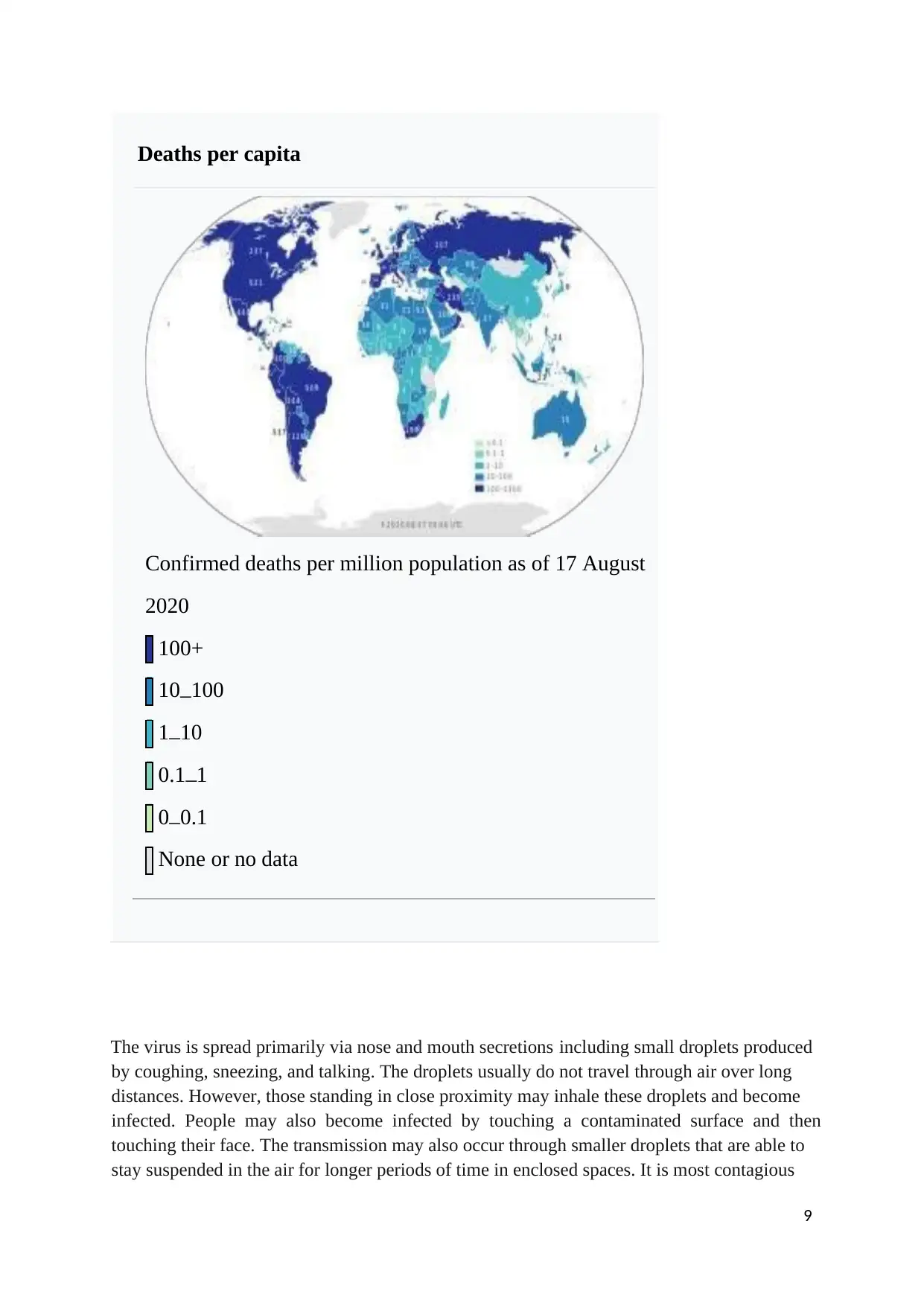
9
The virus is spread primarily via nose and mouth secretions including small droplets produced
by coughing, sneezing, and talking. The droplets usually do not travel through air over long
distances. However, those standing in close proximity may inhale these droplets and become
infected. People may also become infected by touching a contaminated surface and then
touching their face. The transmission may also occur through smaller droplets that are able to
stay suspended in the air for longer periods of time in enclosed spaces. It is most contagious
Deaths per capita
Confirmed deaths per million population as of 17 August
2020
100+
10–100
1–10
0.1–1
0–0.1
None or no data
The virus is spread primarily via nose and mouth secretions including small droplets produced
by coughing, sneezing, and talking. The droplets usually do not travel through air over long
distances. However, those standing in close proximity may inhale these droplets and become
infected. People may also become infected by touching a contaminated surface and then
touching their face. The transmission may also occur through smaller droplets that are able to
stay suspended in the air for longer periods of time in enclosed spaces. It is most contagious
Deaths per capita
Confirmed deaths per million population as of 17 August
2020
100+
10–100
1–10
0.1–1
0–0.1
None or no data
⊘ This is a preview!⊘
Do you want full access?
Subscribe today to unlock all pages.

Trusted by 1+ million students worldwide
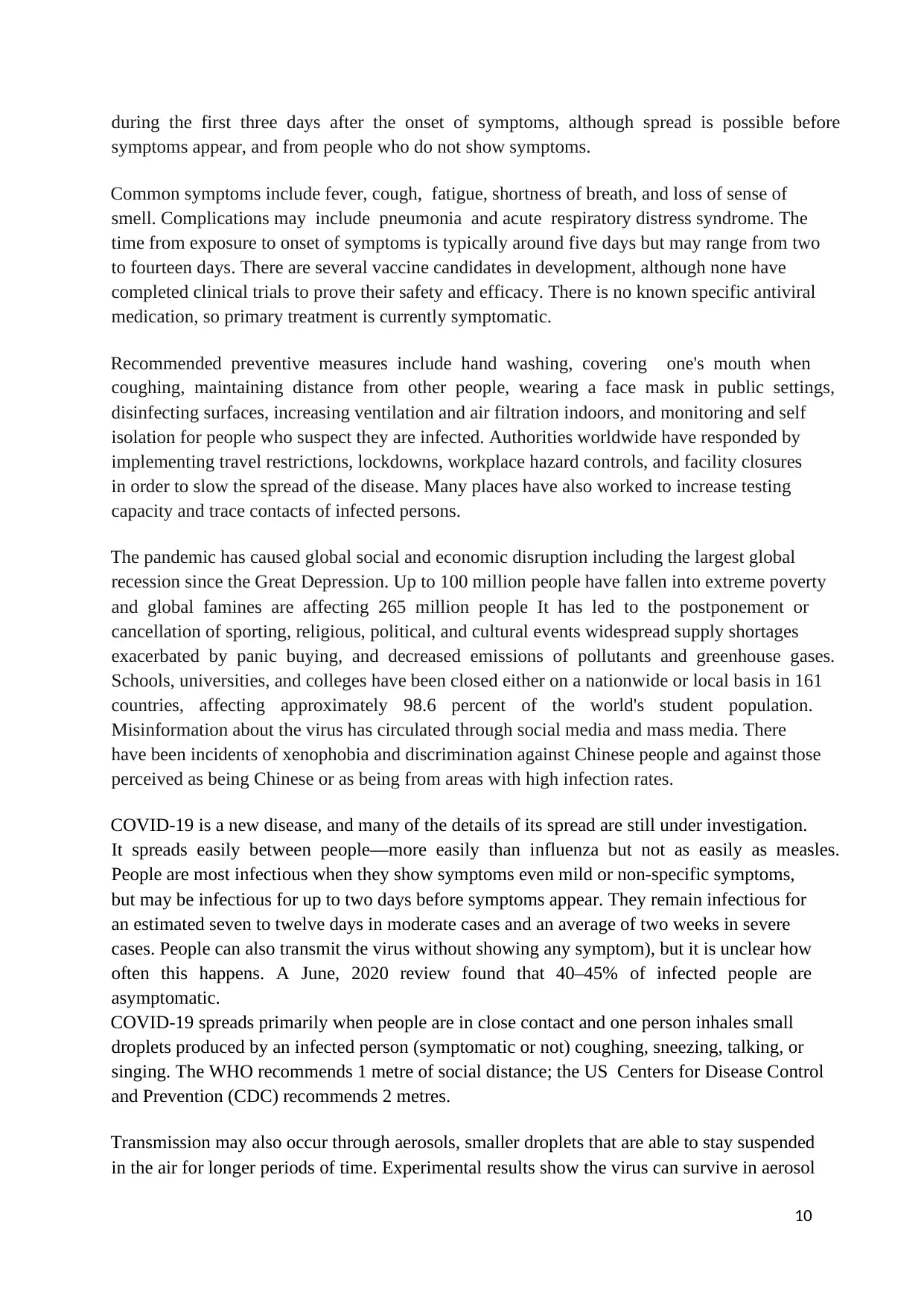
10
during the first three days after the onset of symptoms, although spread is possible before
symptoms appear, and from people who do not show symptoms.
Common symptoms include fever, cough, fatigue, shortness of breath, and loss of sense of
smell. Complications may include pneumonia and acute respiratory distress syndrome. The
time from exposure to onset of symptoms is typically around five days but may range from two
to fourteen days. There are several vaccine candidates in development, although none have
completed clinical trials to prove their safety and efficacy. There is no known specific antiviral
medication, so primary treatment is currently symptomatic.
Recommended preventive measures include hand washing, covering one's mouth when
coughing, maintaining distance from other people, wearing a face mask in public settings,
disinfecting surfaces, increasing ventilation and air filtration indoors, and monitoring and self
isolation for people who suspect they are infected. Authorities worldwide have responded by
implementing travel restrictions, lockdowns, workplace hazard controls, and facility closures
in order to slow the spread of the disease. Many places have also worked to increase testing
capacity and trace contacts of infected persons.
The pandemic has caused global social and economic disruption including the largest global
recession since the Great Depression. Up to 100 million people have fallen into extreme poverty
and global famines are affecting 265 million people It has led to the postponement or
cancellation of sporting, religious, political, and cultural events widespread supply shortages
exacerbated by panic buying, and decreased emissions of pollutants and greenhouse gases.
Schools, universities, and colleges have been closed either on a nationwide or local basis in 161
countries, affecting approximately 98.6 percent of the world's student population.
Misinformation about the virus has circulated through social media and mass media. There
have been incidents of xenophobia and discrimination against Chinese people and against those
perceived as being Chinese or as being from areas with high infection rates.
COVID-19 is a new disease, and many of the details of its spread are still under investigation.
It spreads easily between people—more easily than influenza but not as easily as measles.
People are most infectious when they show symptoms even mild or non-specific symptoms,
but may be infectious for up to two days before symptoms appear. They remain infectious for
an estimated seven to twelve days in moderate cases and an average of two weeks in severe
cases. People can also transmit the virus without showing any symptom), but it is unclear how
often this happens. A June, 2020 review found that 40–45% of infected people are
asymptomatic.
COVID-19 spreads primarily when people are in close contact and one person inhales small
droplets produced by an infected person (symptomatic or not) coughing, sneezing, talking, or
singing. The WHO recommends 1 metre of social distance; the US Centers for Disease Control
and Prevention (CDC) recommends 2 metres.
Transmission may also occur through aerosols, smaller droplets that are able to stay suspended
in the air for longer periods of time. Experimental results show the virus can survive in aerosol
during the first three days after the onset of symptoms, although spread is possible before
symptoms appear, and from people who do not show symptoms.
Common symptoms include fever, cough, fatigue, shortness of breath, and loss of sense of
smell. Complications may include pneumonia and acute respiratory distress syndrome. The
time from exposure to onset of symptoms is typically around five days but may range from two
to fourteen days. There are several vaccine candidates in development, although none have
completed clinical trials to prove their safety and efficacy. There is no known specific antiviral
medication, so primary treatment is currently symptomatic.
Recommended preventive measures include hand washing, covering one's mouth when
coughing, maintaining distance from other people, wearing a face mask in public settings,
disinfecting surfaces, increasing ventilation and air filtration indoors, and monitoring and self
isolation for people who suspect they are infected. Authorities worldwide have responded by
implementing travel restrictions, lockdowns, workplace hazard controls, and facility closures
in order to slow the spread of the disease. Many places have also worked to increase testing
capacity and trace contacts of infected persons.
The pandemic has caused global social and economic disruption including the largest global
recession since the Great Depression. Up to 100 million people have fallen into extreme poverty
and global famines are affecting 265 million people It has led to the postponement or
cancellation of sporting, religious, political, and cultural events widespread supply shortages
exacerbated by panic buying, and decreased emissions of pollutants and greenhouse gases.
Schools, universities, and colleges have been closed either on a nationwide or local basis in 161
countries, affecting approximately 98.6 percent of the world's student population.
Misinformation about the virus has circulated through social media and mass media. There
have been incidents of xenophobia and discrimination against Chinese people and against those
perceived as being Chinese or as being from areas with high infection rates.
COVID-19 is a new disease, and many of the details of its spread are still under investigation.
It spreads easily between people—more easily than influenza but not as easily as measles.
People are most infectious when they show symptoms even mild or non-specific symptoms,
but may be infectious for up to two days before symptoms appear. They remain infectious for
an estimated seven to twelve days in moderate cases and an average of two weeks in severe
cases. People can also transmit the virus without showing any symptom), but it is unclear how
often this happens. A June, 2020 review found that 40–45% of infected people are
asymptomatic.
COVID-19 spreads primarily when people are in close contact and one person inhales small
droplets produced by an infected person (symptomatic or not) coughing, sneezing, talking, or
singing. The WHO recommends 1 metre of social distance; the US Centers for Disease Control
and Prevention (CDC) recommends 2 metres.
Transmission may also occur through aerosols, smaller droplets that are able to stay suspended
in the air for longer periods of time. Experimental results show the virus can survive in aerosol
Paraphrase This Document
Need a fresh take? Get an instant paraphrase of this document with our AI Paraphraser
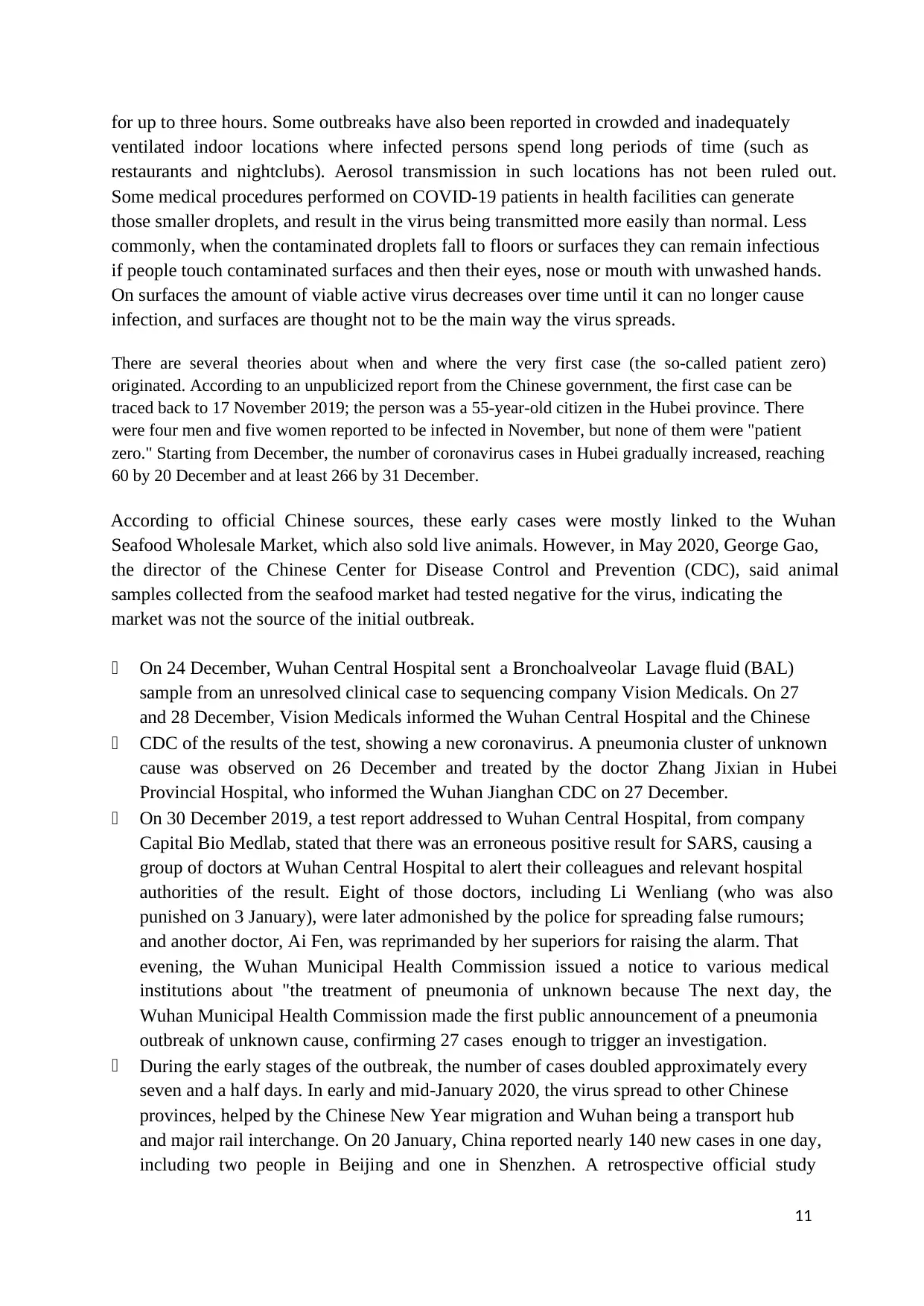
11
for up to three hours. Some outbreaks have also been reported in crowded and inadequately
ventilated indoor locations where infected persons spend long periods of time (such as
restaurants and nightclubs). Aerosol transmission in such locations has not been ruled out.
Some medical procedures performed on COVID-19 patients in health facilities can generate
those smaller droplets, and result in the virus being transmitted more easily than normal. Less
commonly, when the contaminated droplets fall to floors or surfaces they can remain infectious
if people touch contaminated surfaces and then their eyes, nose or mouth with unwashed hands.
On surfaces the amount of viable active virus decreases over time until it can no longer cause
infection, and surfaces are thought not to be the main way the virus spreads.
There are several theories about when and where the very first case (the so-called patient zero)
originated. According to an unpublicized report from the Chinese government, the first case can be
traced back to 17 November 2019; the person was a 55-year-old citizen in the Hubei province. There
were four men and five women reported to be infected in November, but none of them were "patient
zero." Starting from December, the number of coronavirus cases in Hubei gradually increased, reaching
60 by 20 December and at least 266 by 31 December.
According to official Chinese sources, these early cases were mostly linked to the Wuhan
Seafood Wholesale Market, which also sold live animals. However, in May 2020, George Gao,
the director of the Chinese Center for Disease Control and Prevention (CDC), said animal
samples collected from the seafood market had tested negative for the virus, indicating the
market was not the source of the initial outbreak.
On 24 December, Wuhan Central Hospital sent a Bronchoalveolar Lavage fluid (BAL)
sample from an unresolved clinical case to sequencing company Vision Medicals. On 27
and 28 December, Vision Medicals informed the Wuhan Central Hospital and the Chinese
CDC of the results of the test, showing a new coronavirus. A pneumonia cluster of unknown
cause was observed on 26 December and treated by the doctor Zhang Jixian in Hubei
Provincial Hospital, who informed the Wuhan Jianghan CDC on 27 December.
On 30 December 2019, a test report addressed to Wuhan Central Hospital, from company
Capital Bio Medlab, stated that there was an erroneous positive result for SARS, causing a
group of doctors at Wuhan Central Hospital to alert their colleagues and relevant hospital
authorities of the result. Eight of those doctors, including Li Wenliang (who was also
punished on 3 January), were later admonished by the police for spreading false rumours;
and another doctor, Ai Fen, was reprimanded by her superiors for raising the alarm. That
evening, the Wuhan Municipal Health Commission issued a notice to various medical
institutions about "the treatment of pneumonia of unknown because The next day, the
Wuhan Municipal Health Commission made the first public announcement of a pneumonia
outbreak of unknown cause, confirming 27 cases enough to trigger an investigation.
During the early stages of the outbreak, the number of cases doubled approximately every
seven and a half days. In early and mid-January 2020, the virus spread to other Chinese
provinces, helped by the Chinese New Year migration and Wuhan being a transport hub
and major rail interchange. On 20 January, China reported nearly 140 new cases in one day,
including two people in Beijing and one in Shenzhen. A retrospective official study
for up to three hours. Some outbreaks have also been reported in crowded and inadequately
ventilated indoor locations where infected persons spend long periods of time (such as
restaurants and nightclubs). Aerosol transmission in such locations has not been ruled out.
Some medical procedures performed on COVID-19 patients in health facilities can generate
those smaller droplets, and result in the virus being transmitted more easily than normal. Less
commonly, when the contaminated droplets fall to floors or surfaces they can remain infectious
if people touch contaminated surfaces and then their eyes, nose or mouth with unwashed hands.
On surfaces the amount of viable active virus decreases over time until it can no longer cause
infection, and surfaces are thought not to be the main way the virus spreads.
There are several theories about when and where the very first case (the so-called patient zero)
originated. According to an unpublicized report from the Chinese government, the first case can be
traced back to 17 November 2019; the person was a 55-year-old citizen in the Hubei province. There
were four men and five women reported to be infected in November, but none of them were "patient
zero." Starting from December, the number of coronavirus cases in Hubei gradually increased, reaching
60 by 20 December and at least 266 by 31 December.
According to official Chinese sources, these early cases were mostly linked to the Wuhan
Seafood Wholesale Market, which also sold live animals. However, in May 2020, George Gao,
the director of the Chinese Center for Disease Control and Prevention (CDC), said animal
samples collected from the seafood market had tested negative for the virus, indicating the
market was not the source of the initial outbreak.
On 24 December, Wuhan Central Hospital sent a Bronchoalveolar Lavage fluid (BAL)
sample from an unresolved clinical case to sequencing company Vision Medicals. On 27
and 28 December, Vision Medicals informed the Wuhan Central Hospital and the Chinese
CDC of the results of the test, showing a new coronavirus. A pneumonia cluster of unknown
cause was observed on 26 December and treated by the doctor Zhang Jixian in Hubei
Provincial Hospital, who informed the Wuhan Jianghan CDC on 27 December.
On 30 December 2019, a test report addressed to Wuhan Central Hospital, from company
Capital Bio Medlab, stated that there was an erroneous positive result for SARS, causing a
group of doctors at Wuhan Central Hospital to alert their colleagues and relevant hospital
authorities of the result. Eight of those doctors, including Li Wenliang (who was also
punished on 3 January), were later admonished by the police for spreading false rumours;
and another doctor, Ai Fen, was reprimanded by her superiors for raising the alarm. That
evening, the Wuhan Municipal Health Commission issued a notice to various medical
institutions about "the treatment of pneumonia of unknown because The next day, the
Wuhan Municipal Health Commission made the first public announcement of a pneumonia
outbreak of unknown cause, confirming 27 cases enough to trigger an investigation.
During the early stages of the outbreak, the number of cases doubled approximately every
seven and a half days. In early and mid-January 2020, the virus spread to other Chinese
provinces, helped by the Chinese New Year migration and Wuhan being a transport hub
and major rail interchange. On 20 January, China reported nearly 140 new cases in one day,
including two people in Beijing and one in Shenzhen. A retrospective official study
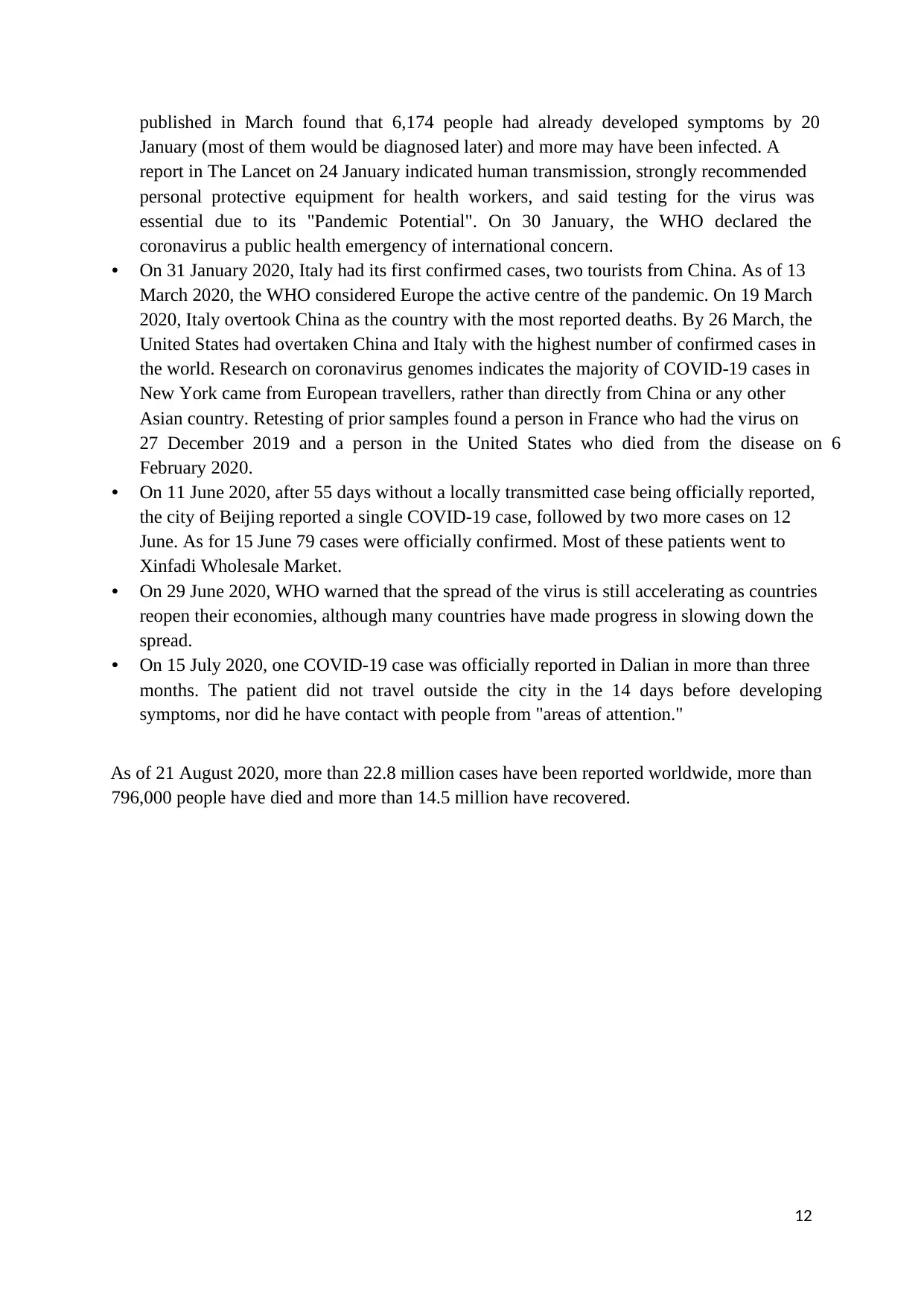
12
published in March found that 6,174 people had already developed symptoms by 20
January (most of them would be diagnosed later) and more may have been infected. A
report in The Lancet on 24 January indicated human transmission, strongly recommended
personal protective equipment for health workers, and said testing for the virus was
essential due to its "Pandemic Potential". On 30 January, the WHO declared the
coronavirus a public health emergency of international concern.
• On 31 January 2020, Italy had its first confirmed cases, two tourists from China. As of 13
March 2020, the WHO considered Europe the active centre of the pandemic. On 19 March
2020, Italy overtook China as the country with the most reported deaths. By 26 March, the
United States had overtaken China and Italy with the highest number of confirmed cases in
the world. Research on coronavirus genomes indicates the majority of COVID-19 cases in
New York came from European travellers, rather than directly from China or any other
Asian country. Retesting of prior samples found a person in France who had the virus on
27 December 2019 and a person in the United States who died from the disease on 6
February 2020.
• On 11 June 2020, after 55 days without a locally transmitted case being officially reported,
the city of Beijing reported a single COVID-19 case, followed by two more cases on 12
June. As for 15 June 79 cases were officially confirmed. Most of these patients went to
Xinfadi Wholesale Market.
• On 29 June 2020, WHO warned that the spread of the virus is still accelerating as countries
reopen their economies, although many countries have made progress in slowing down the
spread.
• On 15 July 2020, one COVID-19 case was officially reported in Dalian in more than three
months. The patient did not travel outside the city in the 14 days before developing
symptoms, nor did he have contact with people from "areas of attention."
As of 21 August 2020, more than 22.8 million cases have been reported worldwide, more than
796,000 people have died and more than 14.5 million have recovered.
published in March found that 6,174 people had already developed symptoms by 20
January (most of them would be diagnosed later) and more may have been infected. A
report in The Lancet on 24 January indicated human transmission, strongly recommended
personal protective equipment for health workers, and said testing for the virus was
essential due to its "Pandemic Potential". On 30 January, the WHO declared the
coronavirus a public health emergency of international concern.
• On 31 January 2020, Italy had its first confirmed cases, two tourists from China. As of 13
March 2020, the WHO considered Europe the active centre of the pandemic. On 19 March
2020, Italy overtook China as the country with the most reported deaths. By 26 March, the
United States had overtaken China and Italy with the highest number of confirmed cases in
the world. Research on coronavirus genomes indicates the majority of COVID-19 cases in
New York came from European travellers, rather than directly from China or any other
Asian country. Retesting of prior samples found a person in France who had the virus on
27 December 2019 and a person in the United States who died from the disease on 6
February 2020.
• On 11 June 2020, after 55 days without a locally transmitted case being officially reported,
the city of Beijing reported a single COVID-19 case, followed by two more cases on 12
June. As for 15 June 79 cases were officially confirmed. Most of these patients went to
Xinfadi Wholesale Market.
• On 29 June 2020, WHO warned that the spread of the virus is still accelerating as countries
reopen their economies, although many countries have made progress in slowing down the
spread.
• On 15 July 2020, one COVID-19 case was officially reported in Dalian in more than three
months. The patient did not travel outside the city in the 14 days before developing
symptoms, nor did he have contact with people from "areas of attention."
As of 21 August 2020, more than 22.8 million cases have been reported worldwide, more than
796,000 people have died and more than 14.5 million have recovered.
⊘ This is a preview!⊘
Do you want full access?
Subscribe today to unlock all pages.

Trusted by 1+ million students worldwide
1 out of 28
Your All-in-One AI-Powered Toolkit for Academic Success.
+13062052269
info@desklib.com
Available 24*7 on WhatsApp / Email
![[object Object]](/_next/static/media/star-bottom.7253800d.svg)
Unlock your academic potential
Copyright © 2020–2025 A2Z Services. All Rights Reserved. Developed and managed by ZUCOL.